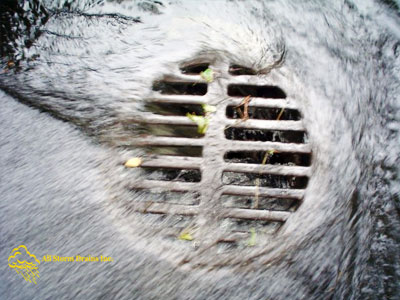What is Storm Water | AllStormDrains.com
WHAT IS STORM WATER?
Storm water (or polluted runoff) is rain or melting snow that flows over the ground. In urban or developed areas, storm water runs over pavement and parking lots, picking up oil and other pollutants before flowing into a nearby river or stream. In more natural areas including forests and wetlands, storm water can soak into the ground, or be stored and filtered.
WHAT ARE THE IMPACTS OF “IMPERVIOUS SURFACES”?
Impervious surfaces such as roads, parking lots, and roofs associated with sprawling urban development significantly change natural river flow patterns and the recharge of underground water supplies.
Rainfall cannot soak into the ground through these surfaces and thus does not replenish groundwater supplies. Impervious surfaces also increase the amount and speed of water entering rivers and other water bodies.
The result is an increase in the severity and frequency of floods, the displacement and destruction of habitat for fish and other water dependent species, and a decrease in base flows in our streams and water in our aquifers.

WHAT ARE THE HEALTH IMPACTS OF POLLUTION?
Urbanization has fundamentally altered the way that water moves through the landscape. When rainwater can’t soak into the ground, it runs along streets and parking lots and picks up pollutants.
This polluted runoff can flow into our rivers and streams, or overwhelm local infrastructure to cause sewage overflows.The public health and environmental implications of sewage overflows are tremendous.
Sewage pollutes our waters with pathogens, excess nutrients, heavy metals, and other toxins.
It kills aquatic life and creates algal blooms that can suffocate fisheries. Sewage carries pathogens that can end up in our drinking water supplies and swimming areas. These disease-causing microorganisms cause diarrhea, vomiting, respiratory, and other infections, hepatitis, dysentery, and other diseases.
HOW SHOULD WE MANAGE STORM WATER?
Traditionally, our water infrastructure— such as storm drains and culverts — has treated precipitation as something to dispose of rather than something to protect. This infrastructure channels rainfall and snow melts into storm drains and pipes, and dumps it into receiving waters, often far from its place of origin. The consequences are the loss of groundwater recharge, reduced base flows in streams, increased flooding, and lower water quality.

Instead of channeling storm water into pipes and drains, a more natural method of water management has benefits for the environment and economy.
Natural storm water management refers to management approaches that accomplish one of three things:
- Use soil and vegetation in a constructed technique, such as rain gardens or green roofs, to mimic natural hydrologic processes like percolation through soil and plant uptake and transpiration.
- Preserve natural features, such as floodplains with a natural vegetation buffer along streams that can slow, filter, and store polluted runoff.
- Minimize or disconnect impervious surfaces (such as pavement), using methods such as rain barrels, narrower streets and permeable paving.
Though these approaches are not as “natural” as other techniques, they still protect the natural water cycle by slowing or infiltrating precipitation rather than sending it directly into storm sewers or nearby streams.
These approaches, when used properly, help maintain a more natural watershed, which in turn keeps our rivers clean and our communities healthy.
THE BENEFITS OF GREEN INFRASTRUCTURE
Green infrastructure solutions (such as permeable pavement, green roofs, and rain gardens) reduce the storm water runoff that flows into sewer systems and triggers sewage overflows. Green infrastructure practices make cities act more like forests by capturing rainwater where it falls, filtering out pollutants and reducing large volumes of runoff.
From rain gardens to green roofs, green infrastructure practices decrease pollutant loading into waters, which can reduce illness from recreational contact or polluted drinking water. Green infrastructure solutions can also improve air quality and mitigate the urban heat island effect to lower heat stress related fatalities. Green infrastructure can mitigate localized flooding. These practices improve access to healthy and affordable food when combined with urban agriculture strategies and to green space for recreation.

SOLUTIONS FOR THE FUTURE
One of the biggest challenges of climate change is the uncertainty and expense it is imposing on communities and businesses. Among the greatest appeals of green infrastructure is the fact that it is cost-effective and reliable – saving money and bringing a much greater degree of certainty and stability to planning processes and investment decisions.
That is why many forward-looking cities are already embracing green infrastructure, including New York, Chicago, Portland, Seattle, San Francisco, Minneapolis-St. Paul, Milwaukee, Kansas City, Toledo, Cincinnati, and Philadelphia.
The investments we make today are ones we will live with for decades and possibly centuries to come. American Rivers is ensuring our leaders make the right decisions for rivers, clean water, and communities and that green solutions become the preferred way to ensure the health and well-being of our children and grandchildren.




Comments
Post a Comment